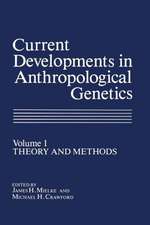Current Developments in Anthropological Genetics: Ecology and Population Structure: Current developments in anthropological genetics, cartea 2
Autor Michael H. Crawford, James H. Mielkeen Limba Engleză Paperback – 4 iun 2013
Preț: 380.80 lei
Preț vechi: 400.85 lei
-5% Nou
Puncte Express: 571
Preț estimativ în valută:
72.87€ • 76.62$ • 60.21£
72.87€ • 76.62$ • 60.21£
Carte tipărită la comandă
Livrare economică 17 aprilie-01 mai
Preluare comenzi: 021 569.72.76
Specificații
ISBN-13: 9781461567714
ISBN-10: 1461567718
Pagini: 544
Ilustrații: XVII, 525 p. 27 illus.
Dimensiuni: 152 x 229 x 29 mm
Greutate: 0.72 kg
Ediția:Softcover reprint of the original 1st ed. 1982
Editura: Springer Us
Colecția Springer
Seria Current developments in anthropological genetics
Locul publicării:New York, NY, United States
ISBN-10: 1461567718
Pagini: 544
Ilustrații: XVII, 525 p. 27 illus.
Dimensiuni: 152 x 229 x 29 mm
Greutate: 0.72 kg
Ediția:Softcover reprint of the original 1st ed. 1982
Editura: Springer Us
Colecția Springer
Seria Current developments in anthropological genetics
Locul publicării:New York, NY, United States
Public țintă
ResearchCuprins
1. Primate Social Organization, Ecology, and Genetic Variation.- 1. Introduction.- 2. The Comparative Method: Fantasy and Fact.- 3. Models of Ecology and Behavior.- 4. Implications for Genetic Research.- 5. Population Structure of Cayo Santiago.- 6. Conclusion.- References.- 2. Population Structures of Ghanzi and Ngamiland !Kung.- 1. Introduction.- 2. Previous Research.- 3. Study Populations.- 4. Methods.- 5. Fertility.- 6. Social Patterns.- 7. Mortality.- 8. Conclusions.- References.- 3. Population Structure of Circumpolar Groups of Siberia, Alaska, Canada, and Greenland.- 1. Introduction.- 2. Methods.- 3. Results.- 4. Conclusions.- References.- 4. Ecology and Biological Structure of Pastoral Isseqqamaren Tuareg.- 1. Introduction.- 2. Pastoralists in an Hyperarid Area.- 3. Social and Geographic Structures.- 4. Other Aspects of Isseqqamaren Dynamics.- 5. A Field Example of Biological Studies in Tuareg Isseqqamaren: Marriages in Ideles.- 6. The Tuareg Isseqqamaren Gene Pool: Preliminary Results for Some Genetic Markers.- 7. Conclusion.- References.- 5. The Population Structure of the Romany Gypsies.- 1. Introduction.- 2. Historical Background.- 3. Demography.- 4. Genetic Structure.- 5. Discussion and Conclusion.- References.- 6. Genetic Architecture of Swidden Agricultural Tribes from the Lowland Rain Forests of South America.- 1. Introduction.- 2. Swidden Agriculture and its Social Concomitants.- 3. The Survival of New Mutations.- 4. Fission Effects in the Formation of New Villages.- 5. The Genetic Consequences of Fusion and Exogamy.- 6. The Production of Tribal Infrastructure and the Evolutionary Radiation of Tribes.- 7. A Prospectus for Future Work.- References.- 7. Genetic Structure of the Semai.- 1. Introduction.- 2. The Semai Senoi People.- 3. Semai Local Populations.- 4. Semai Marriage Patterns.- 5. Semai Demography.- 6. Fission-Fusion and Lineal/Kinship Effect.- 7. Kin-Structured Migration.- 8. Genetic Variation.- 9. Conclusions.- References.- 8. Spatial Autocorrelation Analysis of Biological Variation on Bougainville Island.- 1. Introduction.- 2. Materials.- 3. Spatial Autocorrelation Analysis.- 4. Results.- 5. Discussion.- References.- 9. Linguistic, Ecological, and Genetic Differentiation in New Guinea and the Western Pacific.- 1. Introduction.- 2. The North Solomons.- 3. New Guinea.- 4. The Gm Hypothesis.- 5. Kar Kar Island.- 6. Northern Populations in PNG.- 7. A Broader Picture.- References.- 10. Historical Population Structure of the Åland Islands, Finland.- 1. Introduction.- 2. Sources for Fenno-Scandian Historical Demography.- 3. Historical Background.- 4. Åland Population Structure: Parish Level.- 5. Åland Population Structure: Village Level.- 6. Household and Family in Åland.- 7. Summary and Conclusions.- 11. Genetic Microevolution in the Åland Islands, Finland.- 1. Introduction.- 2. Genetic Analysis.- 3. Migration Analysis.- 4. Migration—Genetics Interaction.- 5. Summary and Conclusions.- References.- 12. Population Structure of Farming Communities of Northern England.- 1. Introduction.- 2. Northumberland.- 3. The Coming of Industry.- 4. Cumbria.- 5. Conclusion.- References.- 13. Population Structure and Anthropometric Variation in Ireland during the 1930’s.- 1. Introduction.- 2. Anthropometric Traits in Population Studies.- 3. Materials, Hypotheses, and Methods.- 4. Results and Discussion.- 5. Conclusion.- References.- 14. Population Structure of a Religious Isolate: The Dariusleut Hutterites of Alberta.- 1. Introduction.- 2. Population Genetic Structure.- 3. Perspectives.- References.- 15. Kinship andInbreeding in Populations of Middle Eastern Origin and Controls.- 1. Introduction.- 2. Degrees of Inbreeding.- 3. Continuous Migration.- 4. Discontinuous Migration.- 5. Artas.- 6. Kallarwan.- 7. Discussion.- 8. Summary.- References.- 16. The Population Structure of an Urban Area in Britain.- 1. Introduction.- 2. Methods.- 3. Results and Discussion.- 4. Conclusions.- References.- 17. New Developments in Anthropological Genetics: Accomplishments and Challenges.


























